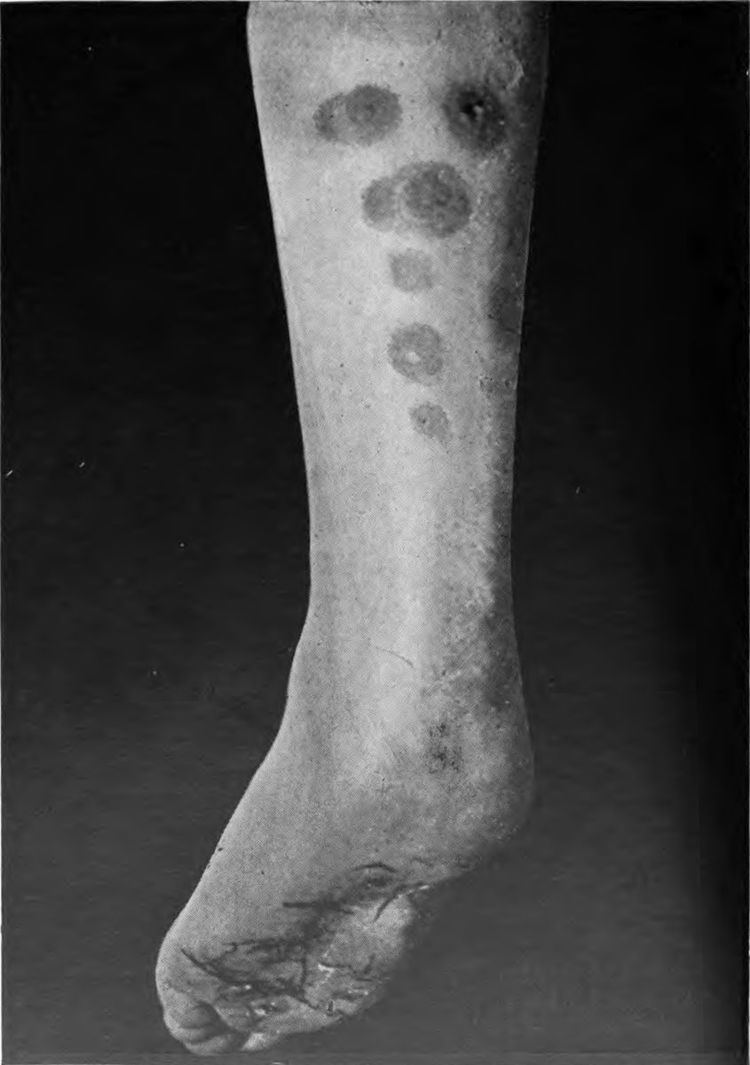Specialty rheumatology ICD-9-CM 729.3 MeSH D015434 | ICD-10 M79.3 DiseasesDB 29081 | |
 | ||
Panniculitis is a group of diseases whose hallmark is inflammation of subcutaneous adipose tissue (the fatty layer under the skin - panniculus adiposus). Symptoms include tender skin nodules, and systemic signs such as weight loss and fatigue.
Contents
- Classification
- With vasculitis
- Without vasculitis
- With needle shaped clefts
- Erythema nodosum
- A1AT deficiency associated
- Signs and symptoms
- Associated conditions
- References
Restated, an inflammatory disorder primarily localized in the subcutaneous fat is termed a "panniculitis," a group of disorders that may be challenging both for the clinician and the dermatopathologist.
Classification
It can occur in any fatty tissue (cutaneous or visceral) and is often diagnosed on the basis of a deep skin biopsy, and can be further classified by histological characteristics based on the location of the inflammatory cells (within fatty lobules or in the septa which separate them) and on the presence or absence of vasculitis.
There are thus four main histological subtypes:
- lobular panniculitis without vasculitis (acute panniculitis, previously termed Weber–Christian disease, systemic nodular panniculitis)
- lobular panniculitis with vasculitis
- septal panniculitis without vasculitis
- septal panniculitis with vasculitis
With vasculitis
Erythema induratum, or "Bazin disease", is a panniculitis on the back of the calves. It was formerly thought to be a reaction to the tuberculum bacillus. It is now considered a panniculitis that is not associated with a single defined pathogen.
Nodular vasculitis is a skin condition characterized by small, tender, reddened nodules on the legs, mostly on the calves and shins. Microscopically there are epithelioid granulomas and vasculitis in the subcutaneous tissue, making it a form of panicullitis. Most of these cases are now thought to be manifestation of tuberculosis and indeed they respond well to anti-tuberculous treatment.
Without vasculitis
Non-vasculitis forms of panniculitis that may occur include:
With needle-shaped clefts
Lipodermatosclerosis is a form of panniculitis associated with chronic venous insufficiency that presents with brown indurations on the front of the shins. It may be associated with pain and other signs of chronic venous insufficiency. The exact cause is unknown.
Other forms include:
Erythema nodosum
Erythema nodosum is a form of panniculitis characterised by tender red nodules, 1–10 cm, associated with systemic symptoms including fever, malaise, and joint pain. Nodules may become bluish-purple, yellowing, and green, and subside over a period of 2–6 weeks without ulcerating or scarring. Erythema nodosum is associated with infections, including Hepatitis C, EBV and tuberculosis, Crohn's disease and sarcoidosis, pregnancy, medications including sulfonamides, and some cancers, including Non-Hodgkin lymphoma and pancreatic cancer.
A1AT-deficiency-associated
Alpha-1 antitrypsin deficiency panniculitis is a panniculitis associated with a deficiency of the α1-antitrypsin enzyme.
Signs and symptoms
Panniculitis can also be classified based on the presence or absence of systemic symptoms. Panniculitis without systemic disease can be a result of trauma or cold; Panniculitis with systemic disease can be caused:
Associated conditions
Lipoatrophy or lipodystrophy (the loss of subcutaneous adipose tissue) can occur in any of these conditions.
